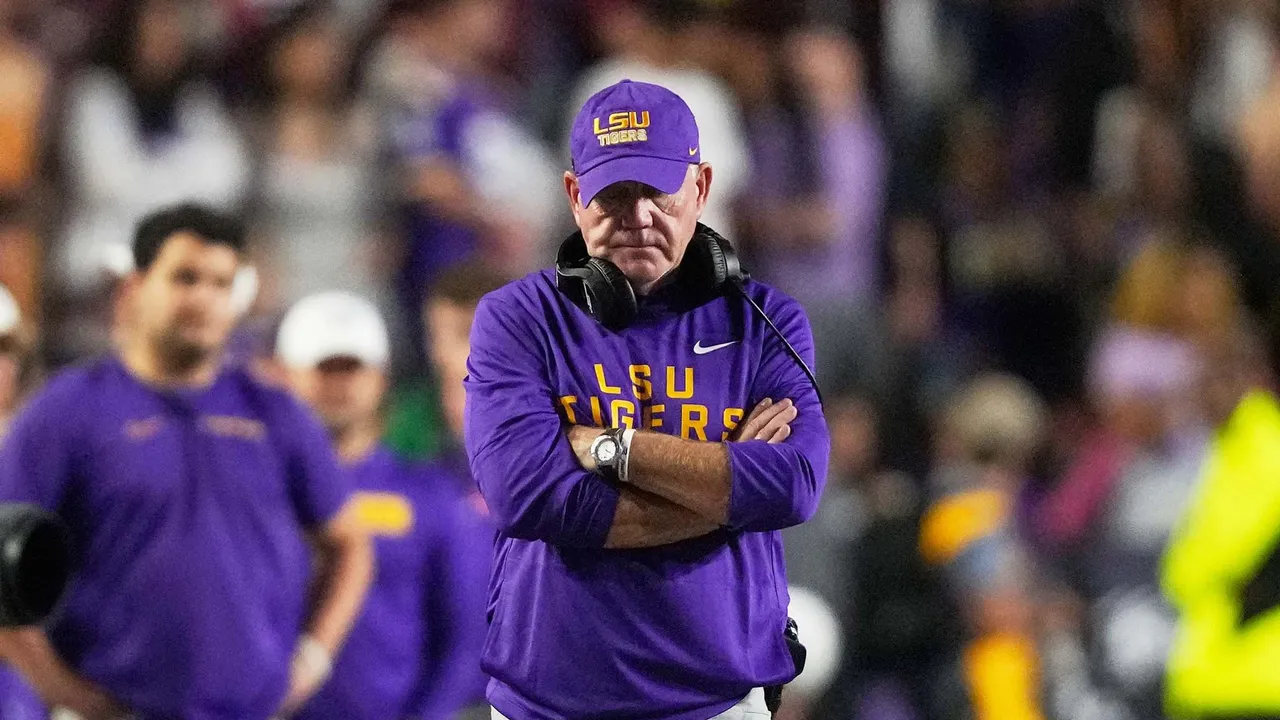Copyright The New Yorker

On Wednesday, the governor of Louisiana, Jeff Landry, held a press conference at the state capitol to address the availability of food assistance for low-income families during the federal-government shutdown. A sign on the lectern read “PROTECTING THE MOST VULNERABLE.” But there were also other urgent matters to discuss, such as the firing of Louisiana State University’s football coach, Brian Kelly. Yes, Landry confirmed, he had been involved in the university’s decision to part ways with Kelly: last Sunday, he had hosted various L.S.U. officials at the governor’s mansion, a twenty-five-thousand-square-foot residence with twelve bedrooms and eighteen bathrooms. No, he went on, the university's athletic director, Scott Woodward, would not be hiring Kelly’s successor. The L.S.U. Board of Supervisors, which was partly appointed by Landry, would create a selection committee, and Woodward wouldn’t be on it. The Governor would make sure of that. “Maybe we’ll let President Trump pick it,” he added. (On Thursday, the school announced that Woodward had resigned as athletic director, too.) This is hardly the first time a Louisiana governor has grandstanded about college football. Huey Long wrote L.S.U. fight songs. What’s stranger is that the rest of the college-football world seems to be following suit. Maybe Trump really is the man for the moment: more and more, college football resembles “The Apprentice.” The season has been filled with upsets, but most of the suspense so far concerns not who will inch up the rankings but which coach will get fired next. There has been unprecedented turnover among coaches in college football’s upper echelon in the past two years. Turnover is common—the “hot seat” is an old trope for a reason—but power-conference schools don’t typically make changes before November. U.C.L.A., Virginia Tech, Oklahoma State, Arkansas, Colorado State, Oregon State, and Florida have all already fired their coaches this season. Penn State fired its coach, James Franklin, even though his team won about seventy per cent of their games, and last season made the semifinals of the College Football Playoff. Penn State began this season ranked No. 2 in the nation. But apparently it made more sense to pay Franklin nearly fifty million dollars not to coach than it did to watch him lose another close game to a top-ten opponent. (Franklin had a .160 winning percentage against those.) According to CBS Sports, ten of the coaches fired so far this season are owed a combined hundred and seventy million dollars. Most of them are public employees. Soaring revenues—particularly from big television deals, at least for teams in the power conferences—help cover those salaries, and boosters help with the buyouts. And there are sometimes loopholes that limit the over-all size of a buyout. But the guaranteed salaries can strain even athletic departments with high revenues—and not every athletic department is quite as rich as it might seem. That hundred and seventy million will soon surely be higher. Michigan’s State’s coach may be toast. Coaches at Kentucky, Middle Tennessee, and Auburn are on the hot seat. And if Bill Belichick is still coaching at the University of North Carolina next season, it will only be because of the program’s demonstrated appetite for bottomless embarrassment. Maybe no one is safe. Last season, Ohio State fans were calling for Ryan Day’s head, after Ohio State lost to Michigan. The Buckeyes went on to win the national championship. Alabama now looks like, well, Alabama, but after the Crimson Tide lost to Florida State in its opener, one ESPN analyst wondered whether their coach, Kalen DeBoer, would “survive September.” Florida State’s fans, meanwhile, are so unhappy with their coach—despite the win over Alabama—that the boosters are spending the rest of the season scrounging for money to pay Mike Norvell’s buyout. He’s owed upward of fifty million dollars. Kelly, the former L.S.U. coach, for his part, went 34–14 during four years at the school, about as good a record as anyone could have reasonably expected. L.S.U. has three losses this season, all to teams currently ranked in the top ten. But Kelly is about as likable as you’d expect a Massachusetts man faking a Southern accent to be—and no self-respecting S.E.C. fan is ready to credit Vanderbilt, which beat L.S.U., 31–24, or Texas A. & M., which embarrassed L.S.U. “I think @LSUsports and the LSU Board of Supervisors needs to rethink their actions to raise ticket prices for next year after tonight’s showing!” Landry tweeted after the game. Landry is in an unusual position to influence L.S.U.’s coaching search because the university is currently without a president and the school’s Board of Supervisors is under his thumb. But that’s only a bayou twist on the what-the-hell-is-happening-in-college-football everywhere else. The role of college-football coaches used to be relatively straightforward: impress top recruits with visions of victories and woo their parents by pretending to enjoy ample helpings of barbeque. Players were unpaid, and stringent transfer rules made it hard for them to leave, which meant that coaches had years to develop skills, implement innovative schemes, instill team philosophies, and generally assert their will. Success was measured in trips to bowl games and wins over historical rivals. Now the transfer portal means that teams can be remade annually on the fly. Coaches have to recruit not only high schoolers but stars from other college teams—and their own players, too, to keep them from transferring. Conference realignment has scrambled old rivalries. The College Football Playoff system has made lesser bowls so unattractive that many players opt out of playing in them, sometimes because they’re already in the process of moving to another team. The playoff system has also made many traditionally middling programs think they have a shot at national glory. There is more parity than there has been in years. Players can get paid now, not only by their teams but by name, image, and likeness collectives, which are organizations, loosely affiliated with schools, that funnel sponsorships to players. And there are rich people with rooting interests all over the country. Boosters are more important than ever. (Gargantuan television contracts are nice, but football is expensive.) Shortly after Virginia Tech fired its football coach (the buyout: six million dollars), the university announced that there would be “limited increases” to student fees, to help cover a planned two-hundred-and-twenty-nine-million-dollar investment in athletics. The Big Ten, which has a seven-billion-dollar television-rights deal, has been flirting with the idea of taking two billion dollars from private equity. Someone has to pay not only the players but also the fired coaches. At his press conference, Landry tried to pin all of college football’s ills, more or less, on Woodward, the now former L.S.U. athletic director. But interspersed in the screed was a real critique of the current system. Coaches’ contracts are out of control. Earlier this month, the coach at Indiana University, Curt Cignetti, signed a contract extension for ninety-three million dollars over eight years. The program has a lot of feel-good stories. Indiana’s starting quarterback, for instance, was so overlooked in high school that he originally committed to play at Yale, and the backup is his younger brother. Indiana—Indiana!—is currently ranked No. 2 in the country. But there’s something wrong with a system in which public universities, which are partly financed by taxpayers, are paying a public employee nearly a hundred million dollars to achieve a level of success that is obviously impossible to sustain in the current college-football landscape. (Not even Nick Saban wanted to try it.) And the idea that the public won’t actually have to pay may be wishful thinking. College football is awash in money, but spending is outpacing typical rises in revenues. “The money does not exist,” one board member at an “affected school” told CNN recently. Landry’s approach to solving the problem so far seems to be to drive away every desirable candidate by talking about compensation that’s dependent on actual accountability—to him, at least, if not to Trump, his dear leader. There’s not a plan there that I can see, certainly not one that aligns with the market for college coaches. But the current situation is also crazy, and if a plausible solution has been offered by any other top school, I haven’t seen it yet. ♦



